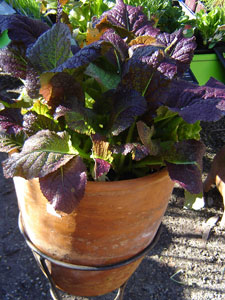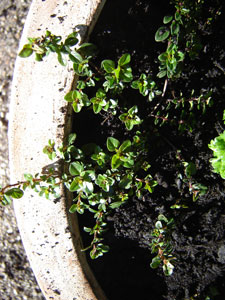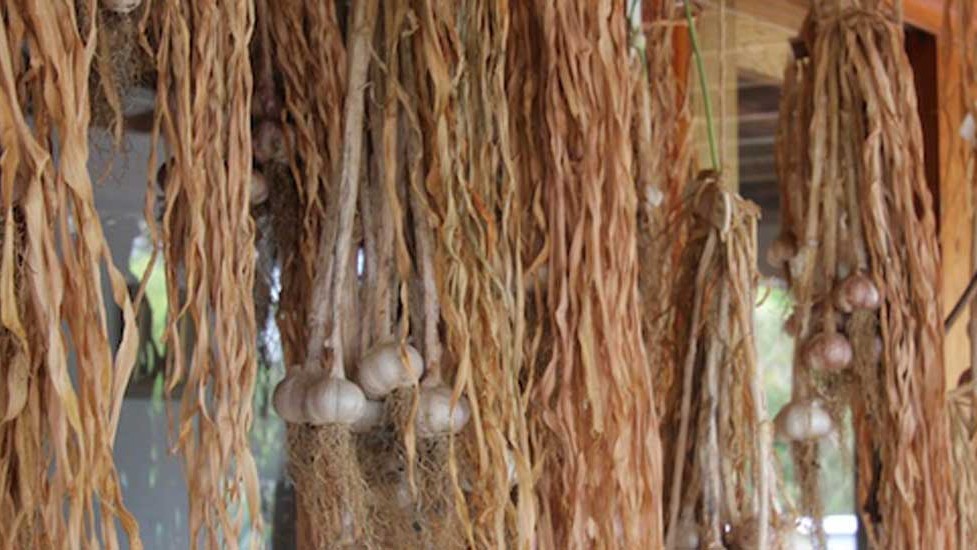 Plants in pots… it’s hardly a new or revolutionary concept… I mean, we are all well acquainted with the potted Maidenhair fern in the bathroom, a dusty ‘Parlour Palm’ struggling for life in the corner of the office, or the ubiquitous ‘Peace Lily’ given as a gift when we can’t think of anything better. But what about productive plants in pots? Imagine a ‘movable feast’ in your inner city courtyard, providing a fair amount of the food you love to eat? A bounty of beautiful herbs out by the BBQ, or tonnes of tumbling tomatoes at your townhouse? Just about anyone has room for a few pots at their place, and we reckon you will be amazed by just how much produce you can grow in just about any space!
Plants in pots… it’s hardly a new or revolutionary concept… I mean, we are all well acquainted with the potted Maidenhair fern in the bathroom, a dusty ‘Parlour Palm’ struggling for life in the corner of the office, or the ubiquitous ‘Peace Lily’ given as a gift when we can’t think of anything better. But what about productive plants in pots? Imagine a ‘movable feast’ in your inner city courtyard, providing a fair amount of the food you love to eat? A bounty of beautiful herbs out by the BBQ, or tonnes of tumbling tomatoes at your townhouse? Just about anyone has room for a few pots at their place, and we reckon you will be amazed by just how much produce you can grow in just about any space!
Gone to Pot – Getting Started
Planting a productive potted plot is no different to getting going in a garden – it’s all about planning, position, potting mix, patience and productivity.
Position
This is all about the best position, not just for your plants, but for you as well. Almost all edible plants will do best in a full sun spot, so spend a bit of time in your patch, and work out where the sun is at it’s most super! Remember, this will vary considerably from winter to summer… but the beauty of planting in pots means you can move them as required to catch the rays! Pop the pots somewhere convenient for you – the closer they are to the house, the more likely they are to be watered (very important) and eaten (also very important!). Make sure that the pots are not blocking access ways, are not sitting in wind tunnels, and are not in the firing line of dogs, cats and wayward balls.
If you just can’t get the right pot position, why not consider going up, rather than down? There is a massive range of tasty treats that can be grown in hanging and wall pots, and this is often an excellent solution for light starved courtyards, or those spaces dominated by our little fur babies (yes, dogs and cats are cute, but they can be a gardener’s nightmare!). Turn the old Hills Hoist into a harvestable haven, or the side fence into a fresh food feast – they make excellent backyard features, and you’ll be the talk of the neighbourhood (in a good way)!
Planning
Containers look best when they’re grouped together, with pots of all different shapes and sizes closely clustered. It has a greater visual impact, cuts down on watering, creates some mini biodiversity and means you don’t have to walk so far to enjoy a plethora of plants. Group plants that require similar levels of watering together, bearing in mind that plants in terracotta pots will dry out a bit faster than others. We know that pots can be pricey (no-one works in horticulture for the money), but check out our Renters Guide To Sustainable Gardening for some great tips for procuring pots. The secret is to never let a pot pass you by… if you see a bargain (or even better, a freebie), grab it, you can always use it for something.

Potting Mix
As anyone who knows me will tell you, I have an unhealthy obsession with healthy soil (which is not a bad thing in itself, but does tend to make fairly boring dinner party conversation). When planting productive pots, the growing medium is incredibly important, but the hot tip here is NOT to use garden soil in pots! Healthy garden soil contains a fantastic mix of microbes, bacteria, fungi and worms… which are great in the garden, but generally don’t perform that well in containers. Garden soil in pots can often have significant drainage issues, and tends to go shabby pretty quickly. The secret to awesome pots is to use a certified organic potting mix, and thankfully, there are now plenty of them around. When opening bags of potting mix, it is important to be aware of the potential for harmful airborne critters to puff out of the bag and into your respiratory system, so consider wearing a mask, and wetting down the potting mix before handling.
Good organic potting mixes will break own over time, so you will need to refresh the pots with new potting mix every so often. Oh, and don’t forget to mulch the tops of all pots with a straw based, locally sourced mulch, to slow down water loss, and prevent weed infestation. As this stuff breaks down, your potting mix will be enriched with natural goodness, minimising the need for additional feeding, saving you both time and money.
Patience…
…is a virtue, so my mother tells me, but this is not always an easy thing to remember in the garden. Consider staggering the planting times of some of your edible favourites (that is, don’t plant 15 tomato plants at once), to prolong the harvest and therefore maximising the yield of your pots. Growing from seed is an excellent way to do this, and while it may be a slightly longer and more tedious process than using seedlings, the extended harvest and money saved may just make it worthwhile for you. Plus, you can often collect and save the seed from many herbs and vegies from one year to the next, which is a good thing for the back pocket, and the planet. Use heirloom varieties whenever possible to ensure the seeds will be viable.
Productivity
Edible gardening is all about maximising productivity, and this is especially important in small space and container gardens. The secret is to plant what you want to eat, and be familiar with plant families and Companion Planting. Depending on the size of your pot, you can often plant a number of different varieties of plant in the one container.
Here are a few suggestions for some winning containerised combinations! Use these as a guide, remembering, the bigger the pot with these the better. If your pots are a little small, use these combinations as suggested plantings for groups of pots… they’ll look great, and you’ll be amazed at just how many incredible edibles you’ll be able to fit into even the smallest space!
The Pasta Pot – One or two tomato plants at the back of the pot. Underplant these with some basil seedlings and a couple of marigolds. At the front of the pot, plant some trailing thyme, marjoram and / or oregano. These will soften the edge of the container, and mean that everything required for a perfect pasta or pizza is in one pot! Plant this pot in spring / summer.

The Stir Fry – Underneath a Kaffir or Tahitian lime in a pot, plant some pick and come again Asian Greens (like Tatsoi, Bok and Pak Choi), and pop in some slow bolt coriander as well. If you don’t have a lime tree, why not use some snow peas as the vertical planting instead? Grow these up a ‘teepee’, and underplant as above. Plant this pot as required in autumn / winter.
The Kickin’ Curry Container – For any lover of home made curries… this container is a cracker! In spring / summer, pop in an Eggplant (or two, if using the smaller Thai eggplants) at the back of the pot. These will need to be staked. Underplant with a Chilli, Spinach, Coriander, and a Curry plant or two, and you are set to whip up a super curry in a hurry. Try this around September. For a winter version replace the eggplant with cauliflower and the spinach with kale. Too easy and darned tasty!
The Season-All – This is a must have for any container gardener. A bay tree in a nice big pot forms an attractive (but somewhat slow growing) centrepiece, surrounded by rosemary (either standard or trailing), thyme, tarragon, parsley and marjoram. Once planted and established, you’ve got yourself an incredibly attractive, fairly drought tolerant, semi-permanent pot planting that will add interest both to the garden, and to your cooking! Plant in spring / summer… and enjoy for ages!!
The Hot-Hot-Hot Pot – In a nice big pot (think half wine barrel size), pop in a capsicum at the back of the pot (remembering it may need to be staked). Whack in a couple of trailing cherry tomatoes, a chilli or two (experiment with these, there are some real winners) and some marigolds for colour and companionship! If you are so inclined, whack in some chives, and you’ve got yourself an instant Mexican feast in a pot! Plant in spring / summer.
The Super Salad – This one is all about the lettuce, particularly the varieties that can be picked from continuously through their growing period. Lob in some Lettuce under a teepee of peas, and pop in some rocket, silverbeet (or spinach depending on the season) and some chives, and you’ve got yourself the fixings of a nice, green salad! Can be planted all year round, just keep the water up to this thirsty pot.
The BBC – Build a teepee, and plant a climbing bean or two. Underplant this by popping in a couple of cauliflower and broccoli seedlings, leaving about 30cm between them. Interplant with a sage or two, and some dill. These will enhance the flavour of the broccoli and cauliflower, and help keep Cabbage White Butterfly at bay. Plant between April and August.
The Happy Apple – Miniature or ‘Ballerina’ apple trees are fantastic in pots, and with the right pollinators nearby, they can be incredibly productive. Underplant these trees in pots with some nasturtium and chives, and you will have yourself a happy potted apple. Plant anytime.
The Hanging Garden – There are so many great varieties of herbs and vegies that will do well in hanging baskets, but here are a few of my tried and true favourites: Strawberries, Tomatoes (in particular the cherry and “pot tumbler” varieties), thyme, marjoram, oregano, prostrate rosemary, mint and chamomile.
While these suggestions are awesome (if I do say so myself), they are by no means the only combinations possible. Remembering the principles of backyard biodiversity and companion planting, you too can come up with your own cool containerised combination!
Related Articles:
No Dig Veggie Gardens
On a recent trip to my local shopping centre (one of those monolithic structures so big it has its own postcode) I was shocked to discover…




